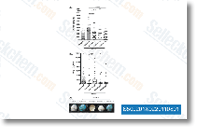The effect of LT turns into detectable only following the 24 h.In general, the HSAECs show the pattern of sensitivity to AnlO, ClnA and LT similar to that with the NMuMG cells. As expected, the therapy with AnlO and ClnA brings about a strong raise in barrier permeability Fostamatinib 1025687-58-4 correlat ing with shedding. This suggests a doable causal rela tionship concerning the 2 processes, which requirements for being elaborated in additional studies. Anthrax infection in mice is accompanied by acceleration of Synd1 shedding The experiments with recombinant proteins described over suggested that Synd shedding could also happen all through anthrax systemic infectious procedure. To verify this hypothesis the DBA. 2 mice had been challenged with B. anthracis spores on the toxigenic Sterne strain intraperito neally as described before.Blood samples were drawn, and serum was examined similar to culture superna tants of protein treated cells making use of immunoblot with the antibody towards Synd1 core protein.
The assay demonstrates a a few fold grow in the level of shed Synd1 to the following day publish challenge.ELISA protocol find more info with all the identical antibody demonstrates very similar success, when diluted serum samples are used to coat the assay plate wells.A substantial degree of circulating ectodomain is sustained right up until two days publish infection. A calibration curve obtained having a management serum spiked with numerous con centrations of recombinant Synd1 enables estimate that normal blood Synd1 concentration at day one post chal lenge is increased by 18g. ml. From the conditions on the experiment, about 50% of ani mals die at day three, and all animals die by day 6 post chal lenge. The onset of death on day 3 is accompanied by a decrease inside the volume of released Synd1, which may very well be explained by several mechanisms, which include degrada tion of syndecan core protein resulting in the reduction of its immunoreactivity with antibodies along with a diminished reten tion in the protein on the surface from the assay membrane or plate.
In any case, the abnormal release of Synd1 into circulation of infected mice immediately signifies that the pathological acceleration of Synd1 shedding takes location in vivo at systemic level and  is accompanied through the processes of its biochemical turnover. Discussion Acceleration of ectodomain shedding represents a a part of an adaptive response in the host cells to diverse stress elements and damage which include G protein coupled receptor in the past nists, growth factors, cytokines, osmotic stress, wounding and phorbol ester activation.However the func tional significance of the ectodomain shedding in micro bial pathology is uncertain. it could both encourage pathogenesis, cellular defenses or both. Microbial mem brane damaging aspects and various harmful toxins can disturb cell homeostasis and serve as powerful inducers of stress pro ceeding as a result of activation of signaling pathways ulti mately resulting in cytoskeletal rearrangements and grow in barrier permeability.A
is accompanied through the processes of its biochemical turnover. Discussion Acceleration of ectodomain shedding represents a a part of an adaptive response in the host cells to diverse stress elements and damage which include G protein coupled receptor in the past nists, growth factors, cytokines, osmotic stress, wounding and phorbol ester activation.However the func tional significance of the ectodomain shedding in micro bial pathology is uncertain. it could both encourage pathogenesis, cellular defenses or both. Microbial mem brane damaging aspects and various harmful toxins can disturb cell homeostasis and serve as powerful inducers of stress pro ceeding as a result of activation of signaling pathways ulti mately resulting in cytoskeletal rearrangements and grow in barrier permeability.A
DUB Signal
Specific genes that can be activated by inducers are called inducible genes.
